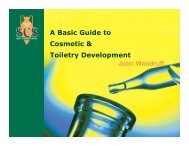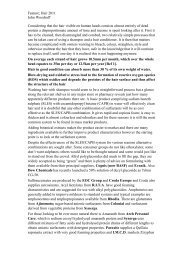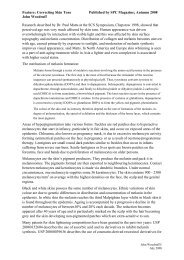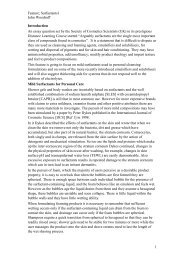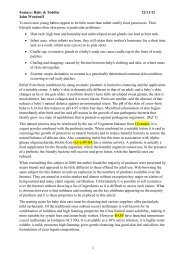Hair Styling Feature - Creative Developments
Hair Styling Feature - Creative Developments
Hair Styling Feature - Creative Developments
Create successful ePaper yourself
Turn your PDF publications into a flip-book with our unique Google optimized e-Paper software.
<strong>Hair</strong> <strong>Styling</strong> 2007 Published in SPC Autumn 2007<br />
John Woodruff<br />
Ever since people had time to socialise with fellow cave dwellers hair they have cut, shaped<br />
and styled their hair. Pictures on coins and pottery illustrate the hairstyles of ancient<br />
civilisations. In the ancient Minoan civilization the women wore their hair long with<br />
elaborately fashioned locks. Egyptian hairstyles varied from one time period to another.<br />
During the Old Kingdom, hairstyles were usually short. During the New Kingdom Period, the<br />
style was to wear the hair longer and sometimes braided. The Romans had simple hairstyles;<br />
men originally had long hair, but later short hair became fashionable. Young girls wore their<br />
hair combed down to the neck, strengthened with ribbons and hairpins, plaited or tied into a<br />
bun. Married Roman women had their hair combed up into a hairstyle called a tutulus. Later,<br />
Roman women wore hairstyles with a parting along the middle of the head. Curly hair was<br />
rolled up into ringlets during sleep and striking and complex high hairstyles composed of<br />
curls arranged in steps above the forehead, so that they formed a rich headband came into<br />
fashion.<br />
The hairstyles of Medieval women were first long and flowing and clearly visible then long<br />
plaits then came into fashion and hair was hidden from view under a wimple <strong>Hair</strong>styles then<br />
changed and coiled buns were displayed on each side of the head then came smooth hair,<br />
parted in the middle and on display above the forehead but the remaining hair was hidden by<br />
a bonnet. In Victorian times hair was often severely damaged from the relentless use of hot<br />
irons and it was not uncommon to have ones hair reduced to a wool-like texture. <strong>Hair</strong> was<br />
never cut except in cases of serious illness.<br />
The simplicity of the smooth, centre-parted styles worn by women in the Victorian era lasted<br />
until the 1870s, when the Parisian hairdresser M. Marcel Grateau created a new, naturallooking<br />
wave using a heated iron that imitated the natural curl of the hair. Hot tongs were<br />
applied to produce a curl rather than a crimp and it revolutionized the art of hairdressing all<br />
over the world and the Marcel wave remained popular for almost half a century.<br />
What is apparent when studying historical hair styles is that in every era they changed as<br />
people chose to emulate the trend setters of their group. Even the means of achieving those<br />
styles has little changed with crimping irons, ceramic tongs, gums and resins and chemical<br />
styling still in common use and the formulator may be briefed to produce products for any<br />
method of hair styling,<br />
What has changed is the bewildering array of product types and the steady improvements in<br />
styling polymers. A presentation by Trevor Baker, Cornelius Produce Co. showed how he<br />
created a classification system to clarify the range of product types used in products for<br />
today’s styling market. He divided products into light and heavy and discussed the various<br />
compositions that fitted this classification. A modified form is tabulated as follows:-<br />
Light Heavy<br />
Serums: low viscosity, usually clear<br />
liquids. Containing water or water free<br />
Liquid emulsions: opaque, viscous liquids<br />
with cream/ lotion texture. Containing<br />
some oil phase<br />
Gels: gelled liquid. Carbomer type,<br />
modified gel type or micro-emulsions<br />
Wax: waxy feel, little or no water<br />
Emulsion: less waxy more cream like<br />
Stick<br />
John Woodruff©<br />
October 2007
<strong>Hair</strong> <strong>Styling</strong> 2007 Published in SPC Autumn 2007<br />
John Woodruff<br />
Mousse pump and aerosol<br />
Sprays; pump and aerosol<br />
The original serums were high molecular weight dimethiconol dispersed in<br />
cyclopentasiloxane. They spread very readily over the hair shaft, seal split ends together and<br />
give shine to the hair. Suppliers of silicone compounds simplify formulation by supplying<br />
prepared dispersions, which are then modified by the addition of further materials. More<br />
cyclopentasiloxane or low viscosity hexamethyldisiloxane may be added to thin the product<br />
or Pecosil G, Phoenix Chemical, Inc, a highly lubricious silicone gel comprising<br />
dimethicone cyclomethicone phenyltrimethicone and trimethylsiloxysilicate may be added to<br />
increase viscosity. Pelemol PTL, INCI: Pentaerythrityl tetralaurate is soluble in<br />
cyclopentasiloxane and may be added as a rheology modifier and phenyl trimethicone is<br />
added to improve gloss.<br />
Although the material cost is high the method of application using a small pump container is<br />
very economical. Alternatively the silicone phase can be emulsified to give a serum-gel and<br />
Wacker Chemie AG produce three dimethiconol emulsions: DP6001 DP is a 60% active<br />
anionic silicone emulsion with a high viscous dimethiconol for improving reduction of wet<br />
and dry combing forces and provides soft hair grip.<br />
Whatever the basis for liquid and gel-type hair styling products the two factors of paramount<br />
importance are hold and shine and it is in these areas where most advance has been made.<br />
Phenyl trimethicone has long been the silicone of choice for adding shine to hair but other<br />
materials with high refractive index such as polybutene are also suitable. Luvitol Lite,<br />
BASF, INCI: Hydrogenated polyisobutene, provides a smoothening function that provides a<br />
more even, softer and smoother hair shaft, resulting in a more intense shine when added to<br />
hair styling products.<br />
Syntrans are a range of bimodal polymers based on polyacrylates from Interpolymer<br />
Corporation suitable for low VOC aerosol application of hair sprays. They claim to provide<br />
quick setting with high humidity curl retention, to be easily removable with minimum buildup<br />
and to provide excellent film flexibility combined with high gloss and good sensorial<br />
properties.<br />
Dow Corning 5-7070 Si Amino Elastomer Emulsion is a combination of amino functionality<br />
to enhance conditioning performance and elastomer technology for styling benefits. INCI:<br />
Silicone quaternium-16 / glycidoxy dimethicone crosspolymer (and) trideceth-12 it is said to<br />
combine good curl retention with flexible hold and<br />
Victorians styled their hair with heating irons, which were extremely damaging. Today’s<br />
equivalents are ceramic tongs, which reach such high temperatures, up to 220°C, that water<br />
within the hair shaft reaches boiling point. The resultant steam causes blistering and raises<br />
the edges of the cuticle and also the strength of the hair is significantly reduced. The<br />
roughened hair requires an increase in combing forces, which results in cuticle loss and hair<br />
breakage. MiruStyle X-HP from Croda is designed to significantly reduce hair damage<br />
caused by thermal styling processes.<br />
Submitted evidence to prove its efficacy shows the results of combing studies, 3-dimensional<br />
SEM imaging techniques, flexabrasion tests and curl retention studies as well as salon trials.<br />
Whereas a hair treated with a basic spritz before thermal styling showed an increase in cuticle<br />
John Woodruff©<br />
October 2007
<strong>Hair</strong> <strong>Styling</strong> 2007 Published in SPC Autumn 2007<br />
John Woodruff<br />
height of about 80%, the addition of 0.5% sodium polystyrene sulfonate or of PVP/DMAPA<br />
acrylates copolymer halved this and 0.5% Mirustyle X-HP actually reduced cubicle height,<br />
thus smoothing the hair. This results in a significant reduction in combing forces required to<br />
style the hair and hair strength was also protected. Curl retention and salon trials also showed<br />
excellent results. MiruStyle X-HP, INCI Aqua, Sodium PEG-40 maleate/styrene sulfonate<br />
copolymer, is soluble in water and aqueous-ethanol up to 60% alcohol content. It is pH and<br />
temperature stable, not affected by electrolytes and forms clear gels with most gelling agents.<br />
Typical usage is 2% to 10% in styling products and shampoos<br />
Particularly recommended for preparing styling mousse Luviquat Supreme,<br />
Polyquaternium-68 from BASF is claimed to provide a natural to strong hold plus added<br />
volume to even the finest hair. <strong>Hair</strong> treated with a 2% solution of Luviquat Supreme in<br />
combination with 1% panthenol is said to have an immense elastic ability so that no matter<br />
the force applied thee hair is able to retain its original hold, shape and volume. It has good<br />
stiffening ability and as little as 1.5% is needed in a hair styling mouse. It provides excellent<br />
curl retention and hair condition, even under high humidity adds more volume and natural,<br />
flexible hold to even the finest hair.<br />
Further reading about hair styles:<br />
http://www.nbs.sk/BIATEC/BIA10_05/26_27.PDF<br />
http://www.middle-ages.org.uk/middle-ages-hairstyles.htm<br />
[http://www.hairarchives.com/private/victorian1new.htm]<br />
http://www.ukhairdressers.com/history%20of%20hair.asp<br />
<strong>Hair</strong> Anatomy; Hashimoto K. MD, University of California at Los Angeles.<br />
http://dermatology.about.com Updated: Aug 14, 2007<br />
The structure of human hair. Clin Dermatol. Oct-Dec 1988;6(4):7-21<br />
Kligman AM. The human hair cycle. J Invest Dermatol. Dec 1959;33:307-1<br />
John Woodruff©<br />
October 2007






